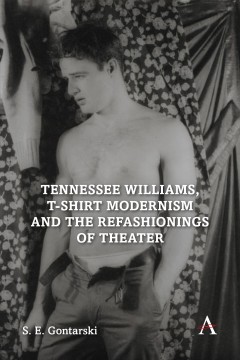Tennessee Williams, T-shirt Modernism and the Refashionings of Theater
By S. E. Gontarski
Other Formats Available:
E-Book- About This Book
- Reviews
- Author Information
- Series
- Table of Contents
- Links
- Podcasts
About This Book
Writing the notes for the exhibition catalogue, Becoming Tennessee Williams, a centenary exhibit at the Harry Ransom Humanities Research Center at the University of Texas (1 February–31 July 2011), Professor and Exhibition Curator Charlotte Cannin noted of Williams’s work that he “reinvented the American theater,” and that “There is no more influential 20th-century American playwright than Tennessee Williams.” “He inspired future generations of writers,” she continues, “as diverse as Suzan-Lori Parks, Tony Kushner, David Mamet and John Waters, and his plays remain among the most produced in the world.” Of A Streetcar Named Desire in particular, critic Philip C. Kolin has said that it is, “One of the most influential plays in the twentieth century.” Kolin’s comment is not restricted to the United States or even to the English-speaking world. A Streetcar Named Desire made an immediate and profound impact on a Europe devastated by World War II, as much of it emerged from beneath the heavy boots of fascism. For Europe, A Streetcar Named Desire was of a piece with liberation, with political liberation, with literary liberation into new forms of expression, and with sexual emancipation. A Streetcar Named Desire suggested for many a new and more open way to live, and offered for writers a set of new possibilities for their art. And while the more sensational Williams may have helped attract large theater and finally film audiences, his endurance as arguably the greatest and most enduring of American dramatists will rest on his language, on his poetic theater, for, after all, as Williams himself has said of his work “Treatment is everything in a play of this type.”
Tennessee Williams, T-shirt Modernism and the Refashionings of Theater refocuses the work of Tennessee Williams against the larger fabric of cultural change in the post–World War II era in which he came to prominence, an era in which the rate of cultural change accelerated unprecedentedly as the late 40s became the 50s, the 50s the 60s, the 60s the 70s, etc. into periods of fragmentation and dislocation, a cultural unmooring we now generally (if too loosely) call postmodern, or, more accurately, perhaps, late modern. The study engages the Williams we thought we knew, as he grew, developed, reconfigured himself into a playwright we didn’t, in his attempts to refashion himself amid the vortices of changing sexual mores, including the performance of masculinities and the queering of theater, the struggle for a literate, literary theater, and the place of the theatrical experience in his contemporary culture.
Reviews
“Gontarski's new book about Tennessee Williams brings us to the sultry Southern stages where T-shirts were not just props randomly taken from wardrobes but new signs of an evocative dramatic language. As his themes became less relevant for modern generations, the playwright's signature appeal changed from erotic ambiguity to stylistic sophistication. And a question arises: is Williams' theatre better suited for American or for European directors? Gontarski looks for answers, his investigations ranging from the heyday of the playwright's global fame to less-studied productions of his work in the 21st century.” — Alessandro Clericuzio, Associate Professor, University of Perugia
“When does a work become a classic of literature and the repertory of reference for theatre? When it lasts over time and reveals ever-increasing new aspects that confirm its relevance and help in understanding the present. This question is the base of the very interesting and original approach of this book, making it to refocus the analysis on Tennessee Williams, to overcome the most current critical studies and concentrate mainly on the latest, though less studied, production, as well as to examine Williams’ creativeness and his growing success outside the United States, especially in Europe.” —Annamaria Cascetta, Full Professor of History of Theatre, Centre of research in theatrical studies of the Università Cattolica del Sacro Cuore, Italy
“By adopting a style that favours immediacy, nicely waving together Williams’ words from his plays, excerpts from theatre critics’ reviews and interviews, and many more from academic and other sources, this book will provide a great reading opportunity and also spur on theatre professionals, e.g., directors, actors, producers, and people passionate about theatre in general and Williams’s work in particular, which is extensively known and recognized both in Europe and America though still not in its entirety.”— Laura Santini, Ricercatrice (RTDa) / Tenure-track lecturer, English Language and Translation, Università di Genova
Author Information
S. E. Gontarski is Robert O. Lawton Distinguished Professor of English at Ohio State University. He is a writer, director and filmmaker who specializes in twentieth-century Irish studies, in British, U.S., and European Modernism, performance theory, history of text technologies and modern(ist) book history.
Series
Anthem Impact
Anthem Studies in Theatre and Performance
Table of Contents
List of Illustrations; Acknowledgments; Saint Tennessee: An Introduction; 1. T-shirt Modernism and Performed Masculinities: The Theatrical Refashionings of Tennessee Williams and William Inge; 2. “Intense Honesty”: Race, Sex and Cross-Cultural Perspectives; 3. Becoming Samuel Beckett: Tennessee Williams and Theatrical Change on the Post–World War II World Stage; 4. Reframing Tennessee: A Short Afterword; Notes; Bibliography; Index.
Links
Stay Updated
Information
Latest Tweets



